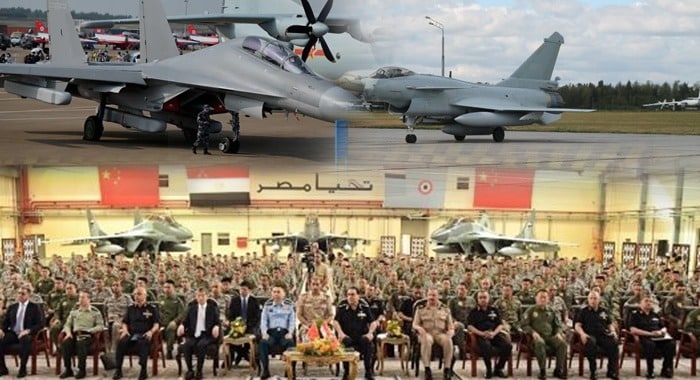The recently concluded “Eagles of Civilisation 2025” air force drills between China and Egypt mark a strategic turning point in Beijing’s bid to expand its counter terrorism and force projection capabilities deep into the Middle East and North Africa (MENA). From April 19 to May 4, the People’s Liberation Army Air Force (PLAAF) deployed a high value air fleet to Egypt, conducting the first ever joint training exercise between the two countries. The operation, while presented as routine military cooperation, carries deeper implications in the context of global counter terror efforts and China’s evolving role in regional security architectures.
The training encompassed advanced air combat drills, joint airstrikes, aerial refuelling, tactical coordination, and battlefield search and-rescue operations tactics typically associated with integrated, rapid response missions against asymmetric threats. Significantly, the exercises emphasized “efficient execution of orders,” “theoretical instruction,” and “air combat skill sharing” phrases that echo the terminology found in global counter terrorism doctrines.
China’s inclusion of the Y-20 strategic transport aircraft, the YY-20 aerial tanker, the KJ-500 early warning aircraft, and advanced J-10C fighter jets showcases its shift toward modular, system based deployments. These aircraft, particularly the Y-20 series, are capable of long range missions that mimic U.S. style rapid deployment operations, such as Washington’s “Rapid Raptor” concept designed for global crisis response, including terror threats in volatile regions.
The PLAAF’s route traversing Pakistan, Iran, the UAE, and Saudi Arabia also highlights the diplomatic and logistical pathways Beijing is carving to enable transcontinental force mobility. These same routes could be crucial in future military responses to terror threats in the Sahel, North Africa, or even further into Sub Saharan Africa, where jihadist movements remain active and international responses are fragmented.
Egypt’s participation specifically with Russian supplied MiG-29s rather than U.S. made F-16s reveals another layer of geopolitical re calibration. As Egypt diversifies its military partnerships beyond Washington, its growing ties with Beijing suggest an alignment rooted not just in arms sales, but in shared interests around border security, surveillance, and suppression of extremist elements—especially in the Sinai Peninsula and neighbouring regions.
The timing of the exercise is equally notable. In a post Russia-Ukraine War global order, Chinese military hardware is increasingly being positioned as an affordable, integrated alternative for countries looking to modernise their armed forces while enhancing their internal security frameworks. China’s willingness to display assets like the J-10C and KJ-500 signals confidence in its next generation air combat development and a potential shift toward exporting entire systems designed for joint operations against asymmetric threats.
Beijing’s broader counter terrorism narrative has long revolved around Xinjiang and the perceived threat of transnational jihadist networks operating via Central Asia. By extending operational experience and logistics networks into Africa, the PLA is building a foundation for projecting deterrence and influence in areas long dominated by Western and Russian actors under the banner of counter terror missions.
Adding to the geo strategic puzzle is Egypt’s confirmed acquisition of the HQ-9B air defense missile system from China a platform designed to counter both aircraft and missile threats. This deal not only alters the regional military balance, particularly in relation to Israel’s aerial dominance, but also illustrates China’s growing footprint in the Middle East’s strategic deterrence landscape.
Analysts warn that China’s use of dual use assets military aircraft disguised as logistical transports, for example blurs the line between humanitarian or technical missions and potential combat deployments. The precedent of delivering HQ-22 systems to Serbia using Y-20s, despite regional isolation, underscores Beijing’s ability to move sensitive hardware covertly under the radar of international monitoring platforms.
As Western intelligence agencies struggle to distinguish between the PLAAF’s transport and combat operations, the potential exists for such capabilities to be leveraged in future flash points from the Horn of Africa to Central Asia especially under the pretext of counter terrorism assistance or peacekeeping. For countries like Taiwan, the implications are even more direct: seemingly benign missions involving Y-20s and YY-20s could mask strategic military movements aimed at destabilizing regions or asserting dominance in contested spaces.
In essence, the “Eagles of Civilisation 2025” was more than a routine drill it was a demonstration of intent. China is no longer content to defend its borders against terror threats. It is now laying the groundwork for regional intervention, international arms diplomacy, and integrated force projection under the plausible cover of counter terror operations.
For intelligence agencies and global counter terrorism coalitions, the signal is clear: Beijing’s air force is taking flight not just across deserts and airspace’s, but into the domain of global influence, crisis response, and security shaping. And it’s doing so in ways that blend diplomacy, defence, and deception.





